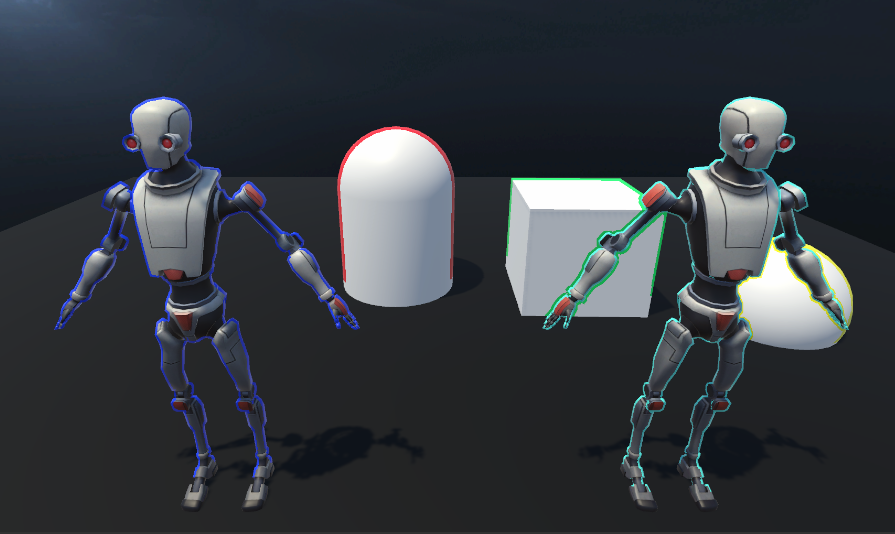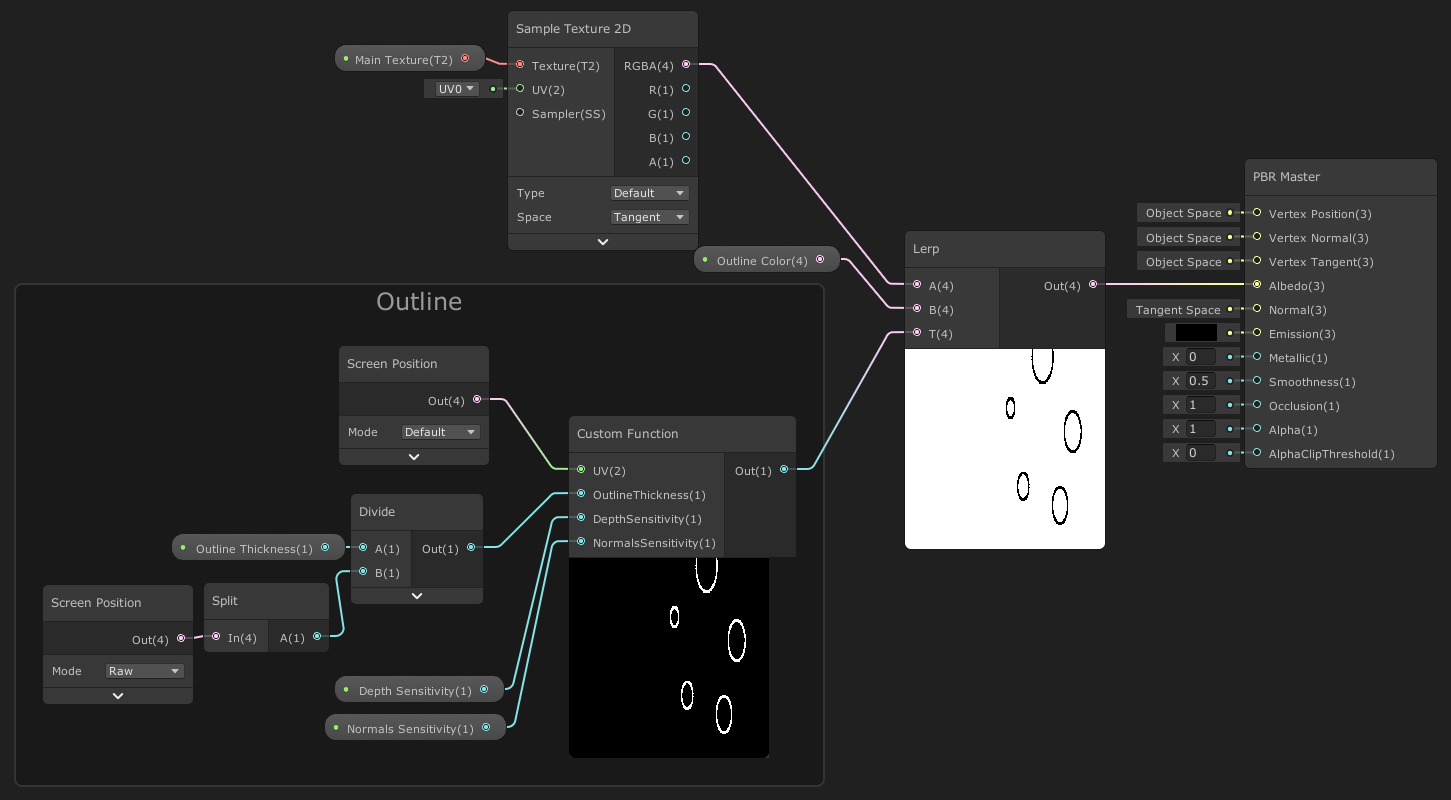Summary
-
CameraDepthNormal 텍스쳐를 이용하여 개별 오브젝트마다 아웃라인을 적용한다.
-
URP Asset의 Depth Texture에 체크해야 한다.
-
MSAA 2x 이상 사용해야 한다.
Preview

Options
| 프로퍼티 | 설명 |
|---|---|
Main Texture |
메인 텍스쳐 |
Outline Color |
아웃라인 색상 |
Outline Thickness |
아웃라인 두께 |
Depth Sensitivity |
아웃라인 생성 기준 깊이값 |
Normals Sensitivity |
별다른 영향을 주지 않음 |
Graph

OutlineObject.hlsl
1
2
3
4
5
6
7
8
9
10
11
12
13
14
15
16
17
18
19
20
21
22
23
24
25
26
27
28
29
30
31
32
33
34
35
36
37
38
39
40
41
42
43
44
45
46
47
48
49
50
51
52
53
54
55
56
57
58
59
60
61
62
63
64
65
66
67
68
69
70
71
72
73
74
// https://alexanderameye.github.io/outlineshader.html
//
// 함수명 : OutlineObject
//
// [파라미터]
// float2 UV : Screen Position Node의 출력을 넣어줌
// float OutlineThickness : 0~10 정도의 값 사용, 2 단위로 굵기 증가
// float DepthSensitivity : 0~1 범위. 이상적인 값은 0.2
// float NormalsSensitivity : 0~1 범위. 딱히 영향 안주는듯
//
// [준비]
// URP Asset의 Depth Texture 체크, MSAA 2x 이상 사용
//
// [적용법]
// Lerp의 A에는 메인 텍스쳐
// B에는 Outline 색상
// T에는 이 함수를 사용한 Custom Function의 Output을 넣어줌
// Lerp의 Out을 Albedo에 적용하면 됨
TEXTURE2D(_CameraDepthTexture);
SAMPLER(sampler_CameraDepthTexture);
float4 _CameraDepthTexture_TexelSize;
TEXTURE2D(_CameraDepthNormalsTexture);
SAMPLER(sampler_CameraDepthNormalsTexture);
float3 DecodeNormal(float4 enc)
{
float kScale = 1.7777;
float3 nn = enc.xyz*float3(2*kScale,2*kScale,0) + float3(-kScale,-kScale,1);
float g = 2.0 / dot(nn.xyz,nn.xyz);
float3 n;
n.xy = g*nn.xy;
n.z = g-1;
return n;
}
void OutlineObject_float(float2 UV, float OutlineThickness, float DepthSensitivity, float NormalsSensitivity, out float Out)
{
float halfScaleFloor = floor(OutlineThickness * 0.5);
float halfScaleCeil = ceil(OutlineThickness * 0.5);
float2 uvSamples[4];
float depthSamples[4];
float3 normalSamples[4];
uvSamples[0] = UV - float2(_CameraDepthTexture_TexelSize.x, _CameraDepthTexture_TexelSize.y) * halfScaleFloor;
uvSamples[1] = UV + float2(_CameraDepthTexture_TexelSize.x, _CameraDepthTexture_TexelSize.y) * halfScaleCeil;
uvSamples[2] = UV + float2(_CameraDepthTexture_TexelSize.x * halfScaleCeil, -_CameraDepthTexture_TexelSize.y * halfScaleFloor);
uvSamples[3] = UV + float2(-_CameraDepthTexture_TexelSize.x * halfScaleFloor, _CameraDepthTexture_TexelSize.y * halfScaleCeil);
for(int i = 0; i < 4 ; i++)
{
depthSamples[i] = SAMPLE_TEXTURE2D(_CameraDepthTexture, sampler_CameraDepthTexture, uvSamples[i]).r;
normalSamples[i] = DecodeNormal(SAMPLE_TEXTURE2D(_CameraDepthNormalsTexture, sampler_CameraDepthNormalsTexture, uvSamples[i]));
}
// Depth
float depthFiniteDifference0 = depthSamples[1] - depthSamples[0];
float depthFiniteDifference1 = depthSamples[3] - depthSamples[2];
float edgeDepth = sqrt(pow(depthFiniteDifference0, 2) + pow(depthFiniteDifference1, 2)) * 100;
float depthThreshold = (1/DepthSensitivity) * depthSamples[0];
edgeDepth = edgeDepth > depthThreshold ? 1 : 0;
// Normals
float3 normalFiniteDifference0 = normalSamples[1] - normalSamples[0];
float3 normalFiniteDifference1 = normalSamples[3] - normalSamples[2];
float edgeNormal = sqrt(dot(normalFiniteDifference0, normalFiniteDifference0) + dot(normalFiniteDifference1, normalFiniteDifference1));
edgeNormal = edgeNormal > (1/NormalsSensitivity) ? 1 : 0;
float edge = max(edgeDepth, edgeNormal);
Out = edge;
}